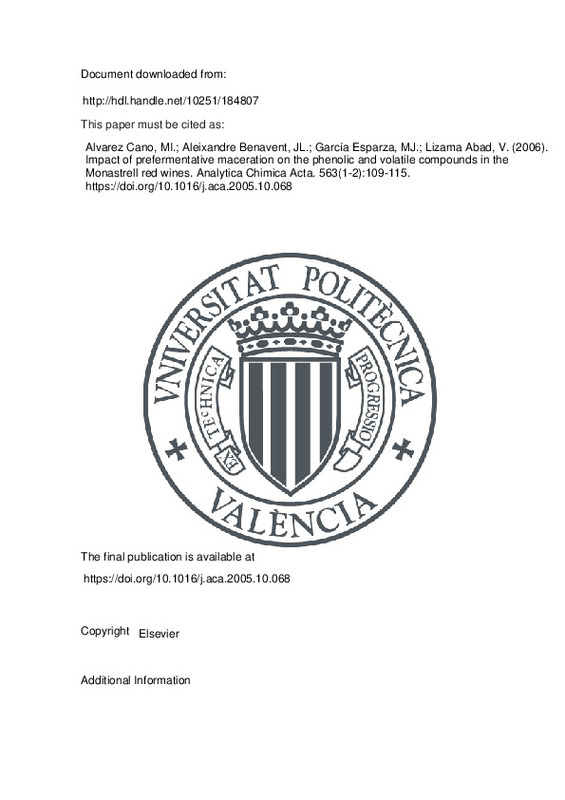JavaScript is disabled for your browser. Some features of this site may not work without it.
Buscar en RiuNet
Listar
Mi cuenta
Estadísticas
Ayuda RiuNet
Admin. UPV
Impact of prefermentative maceration on the phenolic and volatile compounds in the Monastrell red wines
Mostrar el registro sencillo del ítem
Ficheros en el ítem
| dc.contributor.author | Alvarez Cano, María Inmaculada
|
es_ES |
| dc.contributor.author | Aleixandre Benavent, José Luís
|
es_ES |
| dc.contributor.author | García Esparza, Mª José
|
es_ES |
| dc.contributor.author | Lizama Abad, Victoria
|
es_ES |
| dc.date.accessioned | 2022-07-26T18:07:33Z | |
| dc.date.available | 2022-07-26T18:07:33Z | |
| dc.date.issued | 2006-03-23 | es_ES |
| dc.identifier.issn | 0003-2670 | es_ES |
| dc.identifier.uri | http://hdl.handle.net/10251/184807 | |
| dc.description.abstract | [EN] The effects of two prefermentation treatments (cold soak at 6¿8 °C and cold soak at 0¿2 °C with dry ice) and two different maceration times (4 and 8 days) in must and wine composition have been studied. Grapes from Vitis vinifera var. Monastrell were harvested at two maturation levels. Total phenolic, colour density, anthocyanins and fractioned anthocyanins, ionized anthocyanins, polymeric pigments colour, condensed tannins and aromatic compounds were estimated. The effects of temperature in the grape juice composition were determined with constant monitoring during the prefermentation step. Significant differences were found among the measured parameters in the grape juice and wine. Prefermentative maceration produces wines with higher phenolics compounds, anthocyanins, especially malvidin-3-glucoside, ionized and polymeric anthocyanins and aromatic compounds values compared to control wines. This increase is more significant when the prefermentation treatments are done with the use of dry ice and the must is produced from less mature grapes. The maceration time showed not to be significant during the process. | es_ES |
| dc.description.sponsorship | The authors wish to acknowledge gratefully the financial support received from the "Consellería de Cultura, Educacion i Esport to Generalitat Valenciana (GV04B-423)" | es_ES |
| dc.language | Inglés | es_ES |
| dc.publisher | Elsevier | es_ES |
| dc.relation.ispartof | Analytica Chimica Acta | es_ES |
| dc.rights | Reserva de todos los derechos | es_ES |
| dc.subject | Cryomaceration | es_ES |
| dc.subject | Dry ice | es_ES |
| dc.subject | Red wine | es_ES |
| dc.subject | Phenolic compounds | es_ES |
| dc.subject | Volatile composition | es_ES |
| dc.subject.classification | TECNOLOGIA DE ALIMENTOS | es_ES |
| dc.title | Impact of prefermentative maceration on the phenolic and volatile compounds in the Monastrell red wines | es_ES |
| dc.type | Artículo | es_ES |
| dc.identifier.doi | 10.1016/j.aca.2005.10.068 | es_ES |
| dc.relation.projectID | info:eu-repo/grantAgreement/GVA//GV04B-423/ | es_ES |
| dc.rights.accessRights | Abierto | es_ES |
| dc.contributor.affiliation | Universitat Politècnica de València. Departamento de Tecnología de Alimentos - Departament de Tecnologia d'Aliments | es_ES |
| dc.description.bibliographicCitation | Alvarez Cano, MI.; Aleixandre Benavent, JL.; García Esparza, MJ.; Lizama Abad, V. (2006). Impact of prefermentative maceration on the phenolic and volatile compounds in the Monastrell red wines. Analytica Chimica Acta. 563(1-2):109-115. https://doi.org/10.1016/j.aca.2005.10.068 | es_ES |
| dc.description.accrualMethod | S | es_ES |
| dc.relation.publisherversion | https://doi.org/10.1016/j.aca.2005.10.068 | es_ES |
| dc.description.upvformatpinicio | 109 | es_ES |
| dc.description.upvformatpfin | 115 | es_ES |
| dc.type.version | info:eu-repo/semantics/publishedVersion | es_ES |
| dc.description.volume | 563 | es_ES |
| dc.description.issue | 1-2 | es_ES |
| dc.relation.pasarela | S\28940 | es_ES |
| dc.contributor.funder | Generalitat Valenciana | es_ES |







![[Cerrado]](/themes/UPV/images/candado.png)

